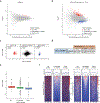CTCF blocks antisense transcription initiation at divergent promoters
- PMID: 36369346
- PMCID: PMC10015438
- DOI: 10.1038/s41594-022-00855-y
CTCF blocks antisense transcription initiation at divergent promoters
Abstract
Transcription at most promoters is divergent, initiating at closely spaced oppositely oriented core promoters to produce sense transcripts along with often unstable upstream antisense transcripts (uasTrx). How antisense transcription is regulated and to what extent it is coordinated with sense transcription is not well understood. Here, by combining acute degradation of the multi-functional transcription factor CTCF and nascent transcription measurements, we find that CTCF specifically suppresses antisense but not sense transcription at hundreds of divergent promoters. Primary transcript RNA-FISH shows that CTCF lowers burst fraction but not burst intensity of uasTrx and that co-bursting of sense and antisense transcripts is disfavored. Genome editing, chromatin conformation studies and high-resolution transcript mapping revealed that precisely positioned CTCF directly suppresses the initiation of uasTrx, in a manner independent of its architectural function. In sum, CTCF shapes the transcriptional landscape in part by suppressing upstream antisense transcription.
© 2022. The Author(s), under exclusive licence to Springer Nature America, Inc.
Conflict of interest statement
Competing interests
The authors declare no competing interests.
Figures













Similar articles
-
A pre-initiation complex at the 3'-end of genes drives antisense transcription independent of divergent sense transcription.Nucleic Acids Res. 2012 Mar;40(6):2432-44. doi: 10.1093/nar/gkr1121. Epub 2011 Nov 28. Nucleic Acids Res. 2012. PMID: 22123739 Free PMC article.
-
Gene regulation by convergent promoters.Nat Genet. 2025 Jan;57(1):206-217. doi: 10.1038/s41588-024-02025-w. Epub 2025 Jan 6. Nat Genet. 2025. PMID: 39779959 Free PMC article.
-
Divergent transcription is associated with promoters of transcriptional regulators.BMC Genomics. 2013 Dec 23;14:914. doi: 10.1186/1471-2164-14-914. BMC Genomics. 2013. PMID: 24365181 Free PMC article.
-
Economy of Effort or Sophisticated Programming? The Prevalence of Bidirectional Promoter Complexes in the Human Genome.Genes (Basel). 2024 Feb 18;15(2):252. doi: 10.3390/genes15020252. Genes (Basel). 2024. PMID: 38397241 Free PMC article. Review.
-
Promoter antisense RNAs: beyond transcription by-products of active promoters.RNA Biol. 2022;19(1):533-540. doi: 10.1080/15476286.2022.2062177. Epub 2021 Dec 31. RNA Biol. 2022. PMID: 35427206 Free PMC article. Review.
Cited by
-
A Small De Novo CNV Deletion of the Paternal Copy of FOXF1, Leaving lncRNA FENDRR Intact, Provides Insight into Their Bidirectional Promoter Region.Noncoding RNA. 2023 Oct 9;9(5):61. doi: 10.3390/ncrna9050061. Noncoding RNA. 2023. PMID: 37888207 Free PMC article.
-
A cis-regulatory element regulates ERAP2 expression through autoimmune disease risk SNPs.Cell Genom. 2024 Jan 10;4(1):100460. doi: 10.1016/j.xgen.2023.100460. Epub 2023 Dec 5. Cell Genom. 2024. PMID: 38190099 Free PMC article.
-
A single high-zinc activation enhancer can control two genes orientated head-to-head in C. elegans.bioRxiv [Preprint]. 2025 Mar 26:2024.11.19.624376. doi: 10.1101/2024.11.19.624376. bioRxiv. 2025. Update in: G3 (Bethesda). 2025 Jul 9;15(7):jkaf089. doi: 10.1093/g3journal/jkaf089. PMID: 40196504 Free PMC article. Updated. Preprint.
-
Dissecting the cis-regulatory syntax of transcription initiation with deep learning.bioRxiv [Preprint]. 2024 Nov 21:2024.05.28.596138. doi: 10.1101/2024.05.28.596138. bioRxiv. 2024. PMID: 38853896 Free PMC article. Preprint.
-
Co-depletion of NIPBL and WAPL balance cohesin activity to correct gene misexpression.PLoS Genet. 2022 Nov 30;18(11):e1010528. doi: 10.1371/journal.pgen.1010528. eCollection 2022 Nov. PLoS Genet. 2022. PMID: 36449519 Free PMC article.
References
-
- Preker P et al. RNA exosome depletion reveals transcription upstream of active human promoters. Science 322, 1851–1854 (2008). - PubMed
Publication types
MeSH terms
Substances
Grants and funding
LinkOut - more resources
Full Text Sources

